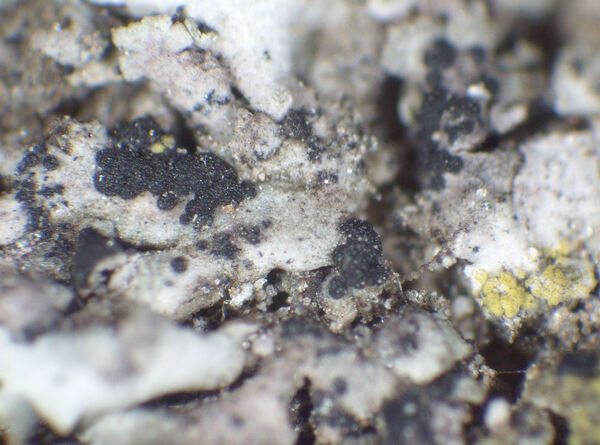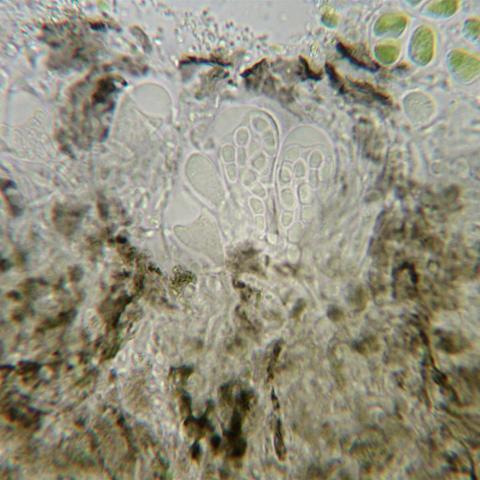Arthonia epiphyscia Nyl.
Flora, 58: 361, 1875.
Synonyms: Bryostigma epiphyscium (Nyl.) S.Y. Kondr. & Hur; Conida epiphyscia (Nyl.) Zopf
Distribution: N - VG, TAA (Ravera & al. 2023b). C - Tosc (Tretiach & al. 2008, Brackel 2016), Abr (Brackel 2015, 2016), Sar (Brackel & Berger 2019). S - Camp (Brackel 2021), Cal (Brackel 2016)
Description: Thallus inapparent, not lichenized, with hyaline vegetative hyphae immersed in the thallus of species of the Physcia adscendens-group. Apothecia arthonioid, round, single or fusing into small groups, developing superficially, 0.1-0.3(-0.4) mm across, with a black, convex, smooth to rough disc, without a distinct margin. Proper exciple poorly developed: epithecium olivaceous brown, 10-15 µm high, K+ olive green; hymenium colourless to pale brown, 30-35(-45) µm high, I+ red, K/I+ blue; paraphysoids c. 2 µm thick, the apical cells to 4 µm wide; hypothecium dark reddish brown, 50-70 µm high, with pigments in intercellular spaces, K+ pale green. Asci 8-spored, broadly clavate, semi-fissitunicate, with a large apical dome, a distinct ocular chamber, and a K/I+ blue ring-structure in tholus, Arthonia-type. Ascospores 1-septate, hyaline, oblong to clavate with an attenuated lower cell, (9-)10-13(-14) x (3-)3.5-5 µm, without a distinct perispore. Photobiont absent. Spot tests: K-, C-, KC-, P-. Chemistry: without lichen substances.Note: commensalistic or parasitic on Physciaceae, this non-lichenised fungus was certainly overlooked and might be more widespread, but is certainly not common in Italy.
Growth form: Lichenicolous fungus
Substrata: bark
Reproductive strategy: mainly sexual
paras Physciaceae
Commonnes-rarity: (info)
Alpine belt: absent
Subalpine belt: absent
Oromediterranean belt: absent
Montane belt: very rare
Submediterranean belt: rare
Padanian area: extremely rare
Humid submediterranean belt: extremely rare
Humid mediterranean belt: extremely rare
Dry mediterranean belt: absent

Predictive model
Herbarium samples
Growth form: Lichenicolous fungus
Substrata: bark
Reproductive strategy: mainly sexual
paras Physciaceae
Commonnes-rarity: (info)
Alpine belt: absent
Subalpine belt: absent
Oromediterranean belt: absent
Montane belt: very rare
Submediterranean belt: rare
Padanian area: extremely rare
Humid submediterranean belt: extremely rare
Humid mediterranean belt: extremely rare
Dry mediterranean belt: absent

Predictive model
| Herbarium samples |
 INDEX FUNGORUM
INDEX FUNGORUM
 GBIF
GBIF
 DOLICHENS
DOLICHENS




